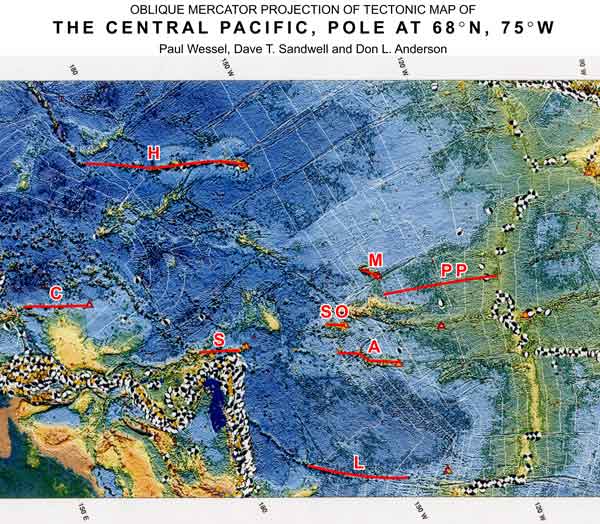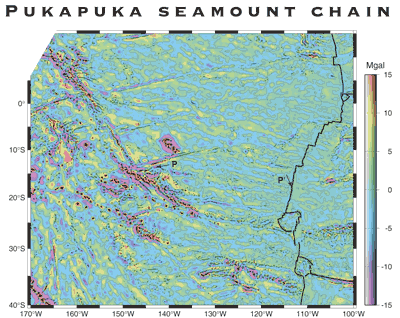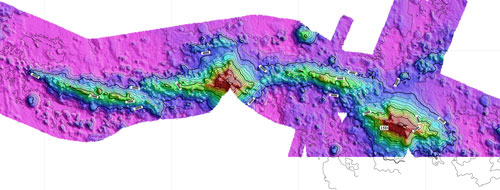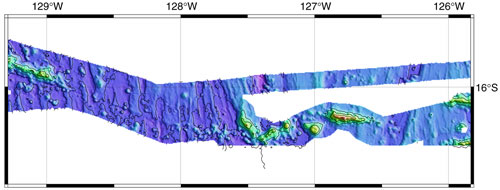 |
 |
The
Pukapuka volcanic chain
|
|
|
|

Map of the Pacific ocean rotated so the Euler
pole is due north. In this view, volcanic chains that
are parallel to plate motion align E-W. Major major
volcanic chains are shown. H: Hawaii, C: Carolines,
S: Samoa, SO: Societies, M: Marquesas, PP: Pukapuka,
A: Australs, L: Louisville.
|
The Pukapuka ("head
of the rock") chain of volcanic ridges
in the southeastern Pacific is traceable for
about 3,000 km, from near the Tuamotus all the
way to the East Pacific Rise (Figure 1). The
ridges are mainly arrayed en echelon (Figure
2). Some of them are closely grouped (Figure
3), and show a consistent scheme of growth.
They begin with small (1 – 2 km) “pancake”
volcanoes distributed along a sigmoidal trace,
followed by stacking on of more small volcanoes
to form a narrow ridge, and finally by the building
of a central volcano with radial rift zones. |

Figure 1. Satellite gravity
map of part of the eastern Pacific, showing
the Pukapuka seamount chain (black dots, P-P’),
aligned in a gravity trough within the set of
parallel gravity ridges and troughs. Seamounts
are about 30 Ma at the western end of the chain,
while the eastern end is at the volcanically
active East Pacific Rise (black line). Click
on figure to enlarge. |
|

Figure 2. Outline map of the Pukapuka
chain, showing the en echelon arrangement of volcanic
ridges.
|

Figure 3. Group of en echelon ridges. Note sigmoid
trends. The ridges are composites of small volcanoes.
|
The strain pattern, suggesting N – S tension
with a component of right-lateral shear, is expressed
only in the distribution of extruded volcanic rocks,
and cannot be discerned in the detailed multibeam
images of the seabed between volcanic ridges (Figure
4). The dikes/pipes that fed the ridges must therefore
be narrow.

Figure 4. Multibeam chart of part
of the Pukapuka chain, showing pre-ridge N-trending
abyssal hill topography, which is not offset by faulting.
The sediment cover is less than 30 m thick.
|
Geochemical evidence favors
a shallow origin for the lavas: “The
lava compositions have weak garnet signatures
and trace element evidence for equilibration
of the most alkalic lavas with residual phlogopite
or amphibole suggest that the Pukapuka lavas
were primarily derived from the shallow upper
mantle rather than a deep-seated mantle plume”
(Janney et al., 2000). Because volcanism
is focused in the troughs of gravity rolls,
indicating tension in the lithosphere, the
rolls are thus viewed as boudins
(Figure 5). (Ed: For an alternative view,
that suggests volcanic ridges are warps and
cracks in the plate due to non-uniform thermal
contraction of the lithosphere, see the Powerpoint
presentation "Cracks
and Warps in the Lithosphere from Thermal
Contraction" by David Sandwell.)
Figure 5. Model for the Pukapuka seamount
chain. Volcanism is focused in the trough
of gravity rolls, indicating tension in the
lithosphere. The rolls are thus viewed as
boudins.
|
|
|
-
Winterer, E.L. & Sandwell,
D.T., 1987, Evidence from en-echelon cross-grain
ridges for tensional cracks in the Pacific plate,
Nature, 329, 534-537.
-
Goodwillie, A.M., 1995, short-wavelength
gravity lineations and unusual flexure results at
the Pukapuka volcanic ridge system, Earth Planet.
Sci. Lett., 136, 297-314.
-
Sandwell, D.T., Winterer, E.L.,
Mammerickx, J., Duncan, R.A., Lynch, M.A., Levitt,
D.A., & Johnson, C.L., 1995, Evidence for diffuse
extension of the Pacific plate from Pukapuka ridges
and cross-grain gravity anomalies, J. Geophys.
Res., 100, 15,087-15,099.
-
Lynch, M.A., 1999, Linear ridge
groups: evidence for tensional cracking in the Pacific
plate, J. Geophys. Res., 104,
29,321-29,333.
-
Janney, P.E., Macdougall, J.D.,
Natland, J.H., & Lynch, M.A., 2000, Geochemical
evidence fom he Pukapuka volcanic ridge system for
a shallow enriched mantle domain beneath the South
Pacific Superswell, Earth Planet. Sci. Lett.,
181, 47-60.
last updated 25th January, 2006 |
|
|
